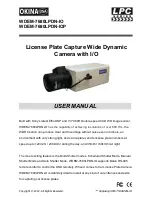
Recommended Power Cables [Reference]
Cable (AWG)
24
22
20
18
16
12 V DC maximum cable length m
(ft.)
5
(16.4)
9
(29.5)
14
(45.9)
23
(75.5)
32
(105.0)
24 V AC maximum cable length m
(ft.)
11
(36.1)
18
(59.1)
29
(95.1)
46
(150.9)
64
(210.0)
Use UL cable (UL-1015 or equivalent) for 12 V DC or 24 V AC wiring.
AC Adapter
Please use the dedicated AC adapter (sold separately).
Remove the power connector attached to the AC adapter, then connect the I/O & Audio
interface cable included in the package, to the power connector, as shown in the following
diagram.
AC Adapter
I/O & Audio Interface
Cable
White
Blue (fat)
Brown (fat)
Green (fat)
Black
Insulate
External Device I/O Terminals
External device I/O terminals consist of two input and output systems each. Viewer can be
used to check external device input status and control output to an external device (please
refer to the “Operation Guide”).
Use the included I/O & Audio interface cable to connect to external device input/output
terminals.
1: BROWN External device input 1 IN1 (+)
2: RED
External device input 2 IN2 (+)
3: BLACK External device input 1, 2 IN1(-), IN2 (-)
4: ORANGE External device output 1 OUT1A
5: YELLOW External device output 1 OUT1B
6: GREEN External device output 2 OUT2A
7: BLUE
External device output 2 OUT2B
External Device Input Terminals (IN1, IN2)
External device input terminals consist of two sets (IN1, IN2) of two terminals, with the negative
terminals connected to the camera interior GND. Connecting cables to the positive and
negative terminals and opening or closing the circuit notifies the Viewer.
Important
When connecting sensors and switches, connect terminals that are electrically isolated from the
respective power and GND.
External Device Output Terminals (OUT1, OUT2)
External device output terminals consist of two sets (OUT1, OUT2) of two terminals. The sets
have no polarity. Controls from the Viewer can be used to open and close the circuit between
the terminals. Using optical couplers, the output terminals are isolated from the camera’s
internal circuit.
Internal Connection Diagram
Inter
nal contr
oller
External device
Input terminal
IN1, IN2
Output terminal
OUT1, OUT2
+3.3 V
0.1 µF
10 k
Ω
10 k
Ω
1 k
Ω
External device
The load connected to the output terminals
should be within the following rating range.
Rating between output terminals:
Maximum voltage 50 V DC
Continuous load current at or below 100 mA
On resistance: Max. 30
Ω
Audio Input/Output Terminals
Each audio input/output terminal has one input system and one output system.
Connecting the camera to an audio input/output device such as a microphone or a speaker
with an amplifier allows you to send/receive audio through the Viewer.
Use the included I/O & Audio interface cable to connect audio input/output devices to the
camera.
Use the 3.5 mm ( 0.14 in.) monaural mini-jack connector to connect an audio input/output
device with the I/O & Audio interface cable.
Audio Input Terminal Common LINE IN/MIC IN (monaural input)
Although the camera has a single audio input system, it supports two types of microphone
input: LINE IN and MIC IN. Before using the audio input, please confirm the [Audio Input] in the
Setting Page (please refer to the “Operation Guide”). LINE IN is selected by default.
Input terminal: 3.5 mm ( 0.14 in.) mini jack (monaural)
•
Dynamic MIC IN
Input impedance: 1.5 k
Ω
±5%
* Supported microphones: Output impedance: 400 – 600
Ω
•
Condenser MIC IN
Input impedance (microphone bias resistance): 2.2 k
Ω
±5%
Microphone power supply: plug-in power (voltage: 2.3 V)
* Supported microphones: Condenser microphones with plug-in power support
•
LINE IN
Input level: Max. 1 Vp-p
* Use a microphone with an amplifier.
Audio Output Terminal LINE OUT (monaural output)
Connect the camera to a speaker with an amplifier. Audio can be sent to the speaker from the
Viewer.
Output terminal: 3.5 mm ( 0.14 in.) mini jack (monaural)
Output level: Max. 1 Vp-p
* Use a speaker with an amplifier.
© CANON INC. 2016
Printed in Japan
Specifications
Please refer to the Appendix – Specifications for specifications not listed below.
Lens
20x optical zoom (20x digital zoom) lens with auto focus
Viewing Angle
For 16:9 aspect ratios
Horizontal: 60.4° (W) – 3.2° (T)
Vertical: 35.1° (W) – 1.8° (T)
For 4:3 aspect ratios
Horizontal: 46.3° (W) – 2.4° (T)
Vertical: 35.1° (W) – 1.8° (T)
Pan Angle Range
348° (±174°)
Tilt Angle Range
90°
– Camera is at 0° when attached to the ceiling and facing straight down, and 90° when at
a horizontal position
Rotation Angle Range 360° (±180°)
Network Terminal*
LAN x 1 (RJ45, 100Base-TX (auto/full-duplex/half-duplex))
* Use a category 5 or better LAN cable, 100 m (328 ft.) or less in length.
Audio Input Terminal
3.5 mm ( 0.14 in.) mini-jack connector (monaural)
(common for LINE IN & MIC IN)
Audio Output Terminal
3.5 mm ( 0.14 in.) mini-jack connector (monaural)
(LINE OUT)
External Device I/O Terminal
Input x 2, Output x 2
Memory Card
SD Memory Card, SDHC Memory Card, SDXC Memory Card Compatible.
Operating Environment
Temperature:
Operating Temperature Range (including direct sun exposure)
AC, PoE+: -50°C – +55°C (-58°F – +131°F) DC, PoE: -10°C – +55°C (+14°F – +131°F)
Start-up Temperature Range (including direct sun exposure)
AC, PoE+: -30°C – +55°C (-22°F – +131°F) DC, PoE: -10°C – +55°C (+14°F – +131°F)
Humidity: 5% – 85% (without condensation)
Temperature:
Operating Temperature Range (including direct sun exposure)
PoE: -10°C – +55°C (+14°F – +131°F)
Start-up Temperature Range (including direct sun exposure)
PoE: -10°C – +55°C (+14°F – +131°F)
Humidity: 5% – 85% (without condensation)
Storage Environment
Temperature: -30°C – +60°C (-22°F – +140°F) Humidity: 5% – 90% (without condensation)
Installation Method
Ceiling mount/Surface mount
Power Supply
PoE: PoE power supply via LAN connector (IEEE802.3at Type1/Type2 compliant)
AC Adapter: PA-V18 (100 – 240 V AC) (sold separately)
External power source: 24 V AC/12 V DC
PoE: PoE power supply via LAN connector (IEEE802.3at Type1 compliant)
IR Illumination Range
60 m (196.9 ft.) (When using 24 V AC, PoE+)
Power Consumption
PoE+: Max. approx. 19.6 W*
1
PoE: Max. approx. 10.4 W*
2
AC Adapter PA-V18: Max. approx. 12.7 W (100 V AC) Max. approx. 12.9 W (240 V AC)
DC: Max. approx. 11.0 W AC: Max. approx. 20.0 W
*
1
Class 4 power sourcing equipment (requests 30.0 W)
*
2
Class 0 power sourcing equipment (requests 15.4 W)
PoE: Max. approx. 7.4 W*
* Class 0 power sourcing equipment (requests 15.4 W)
Weight
Approx. 3420 g (7.54 lb.)
Approx. 3360 g (7.41 lb.)
Impact Resistance
IK09 (10J)
Dust-resistant/
IP66
Waterproof Specification
Connecting the Camera
Power Connection
Please be sure to read the user manual for the dedicated power supply before use.
Note
•
Power supply should conform to all local codes.
•
The power supply should also comply with IEC/UL60950-1 (SELV/LPS) standards.
PoE+
/PoE (Power over Ethernet)
Power can be supplied to the camera by using a LAN cable connected to a PoE+/PoE HUB
that conforms to the IEEE802.3at Type2 (PoE+)/Type1 (PoE) standard.
Important
•
Check with your dealer for more information about PoE+/PoE HUB and Midspan technology.
Midspan (a LAN cable power supply device) is a device that, like a PoE+/PoE HUB, supplies power
to the camera via a LAN cable.
•
Some PoE+/PoE HUBs allow the limitation of power for each port, but applying limits may interfere
with performance. If using this type of PoE+/PoE HUB, do not limit the operating power.
•
Some PoE+/PoE HUBs have limits for the total power consumption for the ports, which can interfere
with performance when multiple ports are in use. For more information, check the instruction guide
for your PoE+/PoE HUB.
•
When the camera is connected to both a PoE+/PoE HUB and an external power supply
(12 V DC or 24 V AC), power will be supplied in the following order of precedence.
External power supply (24 V AC) > PoE+/PoE HUB > External power supply (12 V DC)
However, when connecting power from both, certain combinations could cause problems such as
unstable network connections. If a problem arises, disable one of the power supplies.
I/O & Audio Interface Cable
To prevent cable connections from shorting out, wrap each individual connection with
insulating tape, and then wrap all of the cables with waterproofing tape.
Please connect all of the connectors to the camera, even if you do not plan to use the external
power supply or the external device/ audio I/O.
GND
1
3
1
7
OUT (White)
IN (Black)
Camera side
External Power Supply
12 V DC or 24 V AC input can be used. Use the included I/O & Audio interface cable to
connect to the camera power connection terminal. 12 V DC can be connected in a non-polar
configuration.
1: BLUE (fat)
24 V AC / 12 V DC non-polar
2: BROWN (fat)
24 V AC / 12 V DC non-polar
3: GREEN (fat)
FG (frame ground)
Important
•
The power supply should be within the following voltage range.
•
24 V AC: Voltage fluctuation within ±10% of 24 V AC (50 Hz or 60 Hz ±0.5 Hz or less)
Current supply capacity of at least 1.0 A per camera
•
12 V DC: Voltage fluctuation within ±10% of 12 V DC
Current supply capacity of at least 1.5 A per camera
•
When using a 12 V DC battery power supply, be sure to connect resistors of at least 0.5 – 1.0
Ω
/20 W in
series to the power line.
•
For an external power supply, use a double-insulated device.
CANON INC.
30-2, Shimomaruko 3-chome, Ohta-ku, Tokyo 146-8501, Japan
CANON EUROPA N.V.
Bovenkerkerweg 59, 1185 XB Amstelveen, The Netherlands




















